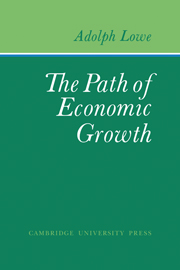Book contents
- Frontmatter
- Contents
- Preface
- Acknowledgments
- PART I The Basic Model
- 1 Introduction: Scope and Method
- 2 Patterns of Economic Growth
- 3 A Schema of Industrial Production
- 4 The Circulation of Fixed Capital
- 5 The Circulation of Working Capital
- 6 The Stationary Process in Operation: Structure Analysis
- 7 The Stationary Process in Operation: Force Analysis
- 8 Transition to Dynamic Equilibrium
- 9 Dynamic Equilibrium: Structure Analysis
- 10 Dynamic Equilibrium: Force Analysis
- PART II Changes in the Rate of Change
- PART III Changes in the Rate of Change
- PART IV Changes in the Rate of Change
- Appendix: An Alternative Presentation of Lowe's Basic Model
- Glossary of Recurring Symbols
- Name Index
- Subject Index
3 - A Schema of Industrial Production
Published online by Cambridge University Press: 07 October 2011
- Frontmatter
- Contents
- Preface
- Acknowledgments
- PART I The Basic Model
- 1 Introduction: Scope and Method
- 2 Patterns of Economic Growth
- 3 A Schema of Industrial Production
- 4 The Circulation of Fixed Capital
- 5 The Circulation of Working Capital
- 6 The Stationary Process in Operation: Structure Analysis
- 7 The Stationary Process in Operation: Force Analysis
- 8 Transition to Dynamic Equilibrium
- 9 Dynamic Equilibrium: Structure Analysis
- 10 Dynamic Equilibrium: Force Analysis
- PART II Changes in the Rate of Change
- PART III Changes in the Rate of Change
- PART IV Changes in the Rate of Change
- Appendix: An Alternative Presentation of Lowe's Basic Model
- Glossary of Recurring Symbols
- Name Index
- Subject Index
Summary
If at any point in time we were to undertake a census of an industrial community's wealth in physical terms, we would find four different stocks of real assets: a stock of labor; a stock of natural resources; a stock of durable equipment goods, such as plant, machinery, residential buildings; and a stock of other goods of rather diverse physical forms and economic uses, which needs further specification.
We would find these stocks distributed among a number of productive units whose activity consists in converting, through certain technical processes, portions of some or all of these stocks into new goods. This activity describes what is meant by “production” in the technical sense of the term – the only sense in which we are interested at the moment.
What we have said so far refers to any sociopolitical order of the economic process, market or collectivist or to any of the mixes of these opposites. The only condition that all these orders must fulfill to fit into our picture of the productive process is that they be industrial systems. Provisionally we call industrial any process of production that uses, as factors of production, not only labor and materials but a stock of equipment goods. The latter term itself will be defined presently as we undertake a further classification of our basic stocks.
First, we can distinguish between original stocks – labor and natural resources, which shall be treated as the ultimate data of the productive process – and manufactured stocks, represented by the last two types of goods included in our list.
- Type
- Chapter
- Information
- The Path of Economic Growth , pp. 24 - 34Publisher: Cambridge University PressPrint publication year: 1976



